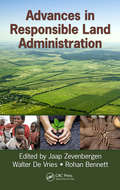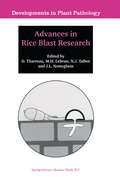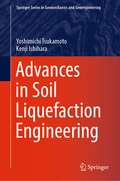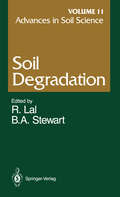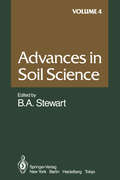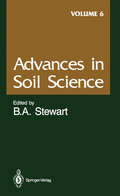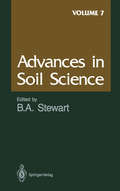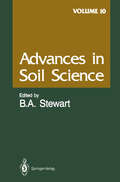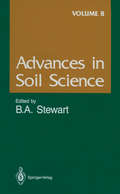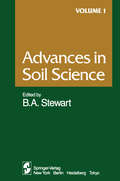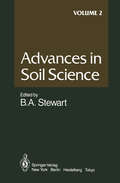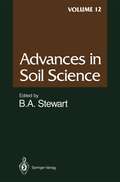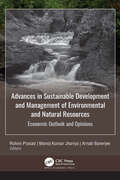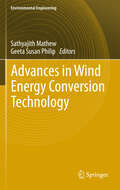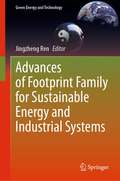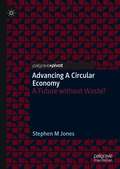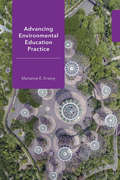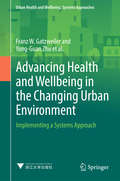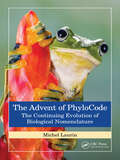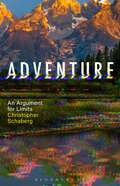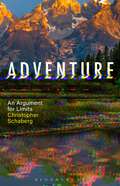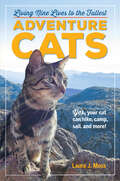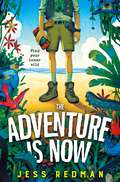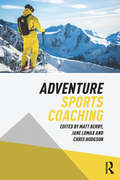- Table View
- List View
Advances in Responsible Land Administration
by Jaap Zevenbergen Walter De Vries Rohan Mark BennettAdvances in Responsible Land Administration challenges conventional forms of land administration by introducing alternative approaches and provides the basis for a new land administration theory. A compilation of observations about responsible land administration in East Africa, it focuses on a new empirical foundation rather than preexisting ideal
Advances in Rice Blast Research: Proceedings of the 2nd International Rice Blast Conference 4–8 August 1998, Montpellier, France (Developments in Plant Pathology #15)
by N. J. Talbot J. L. Notteghem D. Tharreau M. H. LebrunAdvances in Rice Blast Research provides a complete overview of the research undertaken on the rice-blast pathosystem. This book gathers in one volume the most recent works on rice blast fungus genetics and molecular biology of pathogenicity, rice blast fungus population studies, and genetics and molecular biology of rice resistance to blast, including resistance gene cloning. It also presents the latest results on resistance breeding and resistance management strategies, epidemiology and disease management. This book is a must for plant pathologists and breeders working on rice blast and also to plant pathologists and breeders dealing with fungal diseases in general, because the rice-blast pathosystem is a model in plant pathology. Advances in Rice Blast Research provides a complete overview of the research undertaken on the rice-blast pathosystem. This book gathers in one volume the most recent works on rice blast fungus genetics and molecular biology of pathogenicity, rice blast fungus population studies, and genetics and molecular biology of rice resistance to blast, including resistance gene cloning. It also presents the latest results on resistance breeding and resistance management strategies, epidemiology and disease management. This book is a must for plant pathologists and breeders working on rice blast and also to plant pathologists and breeders dealing with fungal diseases in general, because the rice-blast pathosystem is a model in plant pathology.
Advances in Soil Liquefaction Engineering (Springer Series in Geomechanics and Geoengineering)
by Yoshimichi Tsukamoto Kenji IshiharaThis book describes recent developments in soil liquefaction engineering and introduces more appropriate procedures than the current ones to evaluate triggering and consequences of soil liquefaction during earthquakes. The topics therefore cover all aspects of soil behaviour following liquefaction during earthquakes. The contents start with new approaches and new findings on characterisation of liquefaction resistance and undrained shear strength of fully saturated, partially saturated, and unsaturated sand, which are fully based on laboratory tests. New approaches and findings are then described on the use of in situ sounding tests for characterising triggering and consequences of soil liquefaction, including post-liquefaction settlement, lateral spreading, and stability against flow slide. All the topics are accompanied by illustrative case history data from recent major earthquakes in Japan.
Advances in Soil Science: Soil Degradation Volume 11 (Advances in Soil Science #11)
by I. P. Abrol P. Alvo F. De Coninck H. Eswaran N. R. Fausey R. K. Gupta R. Lal T. J. Logan D. A. MacLeod E. McKyes C. E. Mullins K. H. Northcote G.S.V. Raghavan G. K. Sims B. A. Stewart J. M. Tisdall T. Varghese I. M. YoungThe purpose of Advances in Soil Science is to provide a forum for leading scientists to analyze and summarize the available scientific information on a subject, assessing its importance and identifying additional research needs. A wide array of subjects has been addressed by authors from many countries in the initial ten volumes of the series. The quick acceptance of the series by both authors and readers has been very gratifying and confirms our perception that a need did exist for a medium to fill the gap between the scientific journals and the comprehensive reference books. This volume is the first of the series devoted entirely to a single topic soil degradation. Future volumes will include both single-topic volumes as well as volumes containing reviews of different topics of soil science, as in the case of the first ten volumes. There are increasing concern and attention about managing natural re sources, particularly soil and water. Soil degradation is clearly one of the most pressing problems facing mankind. Although the spotlight regarding soil degradation in recent years has focused on Africa, concern about the degradation of soil and water resources is worldwide. The widespread con cern about global environmental change is also being linked to severe problems of soil degradation. Therefore, we are indeed pleased that the first volume of the series devoted to a single topic addresses such an impor tant issue. The current volume is also the first of the series involving a guest editor.
Advances in Soil Science: Volume 4 (Advances in Soil Science #4)
by L. R. Ahuja W. H. Gardner D. R. Keeney K. L. Sahrawat I. SzabolcsThe world needs for food and fiber continue to increase. Population growth in the developing countries peaked at 2. 4 percent a year in 1965, and has fallen to about 2. 1 percent. However, in many developing countries almost half the people are under 15 years of age, poised to enter their productive and reproductive years. The challenges to produce enough food for this growing population will remain great. Even more challenging is growing the food in the areas of greatest need. Presently the world has great surpluses of food and fiber in some areas while there are devastating deficiencies in other areas. Economic conditions and the lack of suitable infrastructure for distribution all too often limit the alleviation of hunger even when there are adequate supplies, sometimes even within the country itself. World hunger can only be solved in the long run by increasing crop production in the areas where the population is growing most rapidly. This will require increased efforts of both the developed and developing countries. Much of the technology that is so successful for crop production in the developed countries cannot be utilized directly in the developing countries. Many of the principles, however, can and must be adapted to the conditions, both physical and economic, of the developing countries.
Advances in Soil Science (Advances in Soil Science #6)
by R. R. Allmaras S. C. Gupta J. Kubota A. D. Scott S. J. Smith D. L. Sparks M. E. Sumner D. Van Campen J. L. Walworth R. M. WelchThe world needs for food and fiber continue to increase. Population growth in the developing countries peaked at 2. 4 percent a year in 1965 and has fallen to about 2. I percent. However, in many developing countries almost half the people are under 15 years of age, poised to enter their productive and reproductive years. The challenges to produce enough food for this growing population will remain great. Even more challenging is growing the food in the areas of greatest need. Presently the world has great surpluses of food and fiber in some areas while there are devastating deficiencies in other areas. Economic conditions and the lack of suitable infrastructure for distribution all too often limit the alleviation of hunger even when there are adequate supplies, sometimes even within the country itself. World hunger can only be solved in the long run by increasing crop production in the areas where the population is growing most rapidly. This will require increased efforts of both the developed and developing countries. Much of the technology that is so successful for crop production in the developed countries cannot be utilized directly in the developing countries. Many of the principles, however, can and must be adapted to the conditions, both physical and economic, of the developing countries. This series, Advances in Soil Science.
Advances in Soil Science (Advances in Soil Science #7)
by D. W. Anderson E. Bresler W. W. Frye L. Metzger M. S. Smith J. J. Varco J. Venkateswarlu B. YaronThe world population in 1950 was 2. 5 billion and is more than 5 billion today. The agriculture community, however, has responded remarkably well to meeting the increased need for food and fiber. While the population growth during this period averaged almost 2% annually, the production of grain increased at an even faster rate. From 1950 to 1973, grain production increased 3. 1% annually, but slowed to about 2% from 1973 to 1984. There fore, as a whole, the world has more grain per capita available today than ever before. Several countries that were food importers just a few years ago are food exporters today. The world carry-over stocks today are the highest in years. While the major concern just a few years ago was whether the world could produce adequate food, the problem for many countries today is how to export their surpluses. Although the world as a whole has surplus food supplies, there are millions of people without adequate food to exist, and there are additional millions who have a bare subsistence diet at best. The average daily calorie supply for the developed countries is more than 3,300 per person, while the average for the developing countries is only about 2,200. The major global food produc tion problems have shifted from Asia to Africa, where malnutrition, poverty, and starvation are attracting world attention.
Advances in Soil Science: Volume 10 (Advances in Soil Science #10)
by E. G. Beauchamp D. Binkley R. J. Buresh S.K. De Datta S. C. Hart M. B. McBride J. W. Paul J. T. Trevors A. Van WambekeSoil is formed from physical and chemical weathering of rocks - processes described historically because they involve eons of time-by glaciation and by wind and water transport of soil materials, later deposited in deltas and loessial planes. Soil undergoes further transformations over time and provides a habitat for biological life and a base for the development of civilizations. Soil is dynamic -always changing as a result of the forces of nature and particularly by human influences. The soil has been studied as long as history has been documented. Numerous references to soil are found in historical writings such as Aristotle (384-322 B. c. ), Theophrastus (372-286 B. c. ), Cato the Elder (234-149 B. C. ) and Varro (116-27 B. c. ). Some of the earliest historical references have to do with erosional forces of wind and water. The study of soils today has taken on increased importance because a rapidly expanding population is placing demands on the soil never before experienced. This has led to an increase in land degradation and desertification. Desertifica tion is largely synonymous with land degradation but in an arid land context. Deterioration of soil resources is largely human induced. Poverty, ignorance, and greed are the indirect causes of desertification. The direct cause is mismanage ment of the land by practices such as overgrazing, tree removal, improper tillage, poorly designed and managed water distribution systems, and overexploitation.
Advances in Soil Science (Advances in Soil Science #8)
by A. R. Bertrand J. C. Day R. J. Gibbs P. M. Huang R. E. Meyer A.S.P. Murthy R. I. Papendick J. B. Reid J. L. SteinerAdvances in Soil Science is a review series relevant to all areas of soil science. These reviews, intended primarily for scientists, teachers, and students of soil science, also provide technical background information for many additional workers and groups interested in our natural resources and man's influence on them. This is the eighth volume in the series with an international list of contributors from the United States, India, Canada and New Zealand. It contains four review chapters on the following subjects: factors affecting aluminum transformations in soil; soil productivity in dryland regions of developing countries; changes in soil structure under different cropping systems; properties and management of the depleted soils of India. These contributions present valuable information on a diversity of topics and serve as an excellent source of references.
Advances in Soil Science (Advances in Soil Science #1)
by F. T. Bingham J. T. Cope H. V. Eck S.A. El-Swaify C. E. Evans L. B. Fenn L. R. Hossner R. Keren J. Letey P. Pathak T. J. Rego U. Schwertmann I. Shainberg S. Singh P. W. UngerThe world population in 1930 was 2 billion. It reached 3 billion in 1960, stands at 4. 6 billion today, and is expected to reach 6 billion by the end of the century. The food and fiber needs of such a rapidly increasing population are enormous. One of the most basic resources, perhaps the most basic of all, for meeting these needs is the soil. There is an urgent need to improve and protect this resource on which the future of mankind directly depends. We must not only learn how to use the soil to furnish our immediate needs, but also ensure that the ability of the soil to sustain food production in the future is unimpaired. This is indeed a mammoth task; a 1977 United Nations survey reported that almost one-fifth of the world's cropland is now being steadily degraded. This volume is the first of a new series entitled Advances in Soil Science. The diversity of soil makes it necessary for research to be conducted in many locations. There are basic principles, however, that are universal. This new series will present clear and concise reviews in all areas of soil science for everyone interested in this basic resource and man's influence on it. The purpose of the series is to provide a forum for leading scientists to analyze and summarize the available scientific information on a subject, assessing its importance and identifYing additional research needs.
Advances in Soil Science: Volume 2 (Advances in Soil Science #2)
by E. Bragg J. M. Lynch K. Mengel C. W. Rose K. WadaThe world population in 1930 was 2 billion. It reached 3 billion in 1960, stands at 4. 6 billion today, and is expected to reach 6 billion by the end of the century. The food and fiber needs of such a rapidly increasing population are enormous. One of the most basic resources, perhaps the most basic of all, for meeting these needs is the soil. There is an urgent need to improve and protect this resource on which the future of mankind directly depends. We must not only learn how to use the soil to furnish our immediate needs, but also ensure that the ability of the soil to sustain food production in the future is unimpaired. This is indeed a mammoth task; a 1977 United Nations survey reported that almost one-fifth of the world's is now being steadily degraded. The diversity of soil makes it cropland necessary for research to be conducted in many locations. There are basic principles, however, that are universal. This, Advances in Soil Sciences, presents clear and concise reviews in all areas of soil science for everyone interested in this basic resource and man's influence on it. The purpose of the series is to provide a forum for leading scientists to analyze and summarize the available scientific information on a subject, assessing its importance and identifying additional research needs. But most importantly, the contributors will develop principles that have practical applications to both developing and developed agricultures.
Advances in Soil Science: Volume 12 (Advances in Soil Science #12)
by S. K. Jalota B. D. Kay S. Komarneni P. B. Malla E. Murad S. S. Prihar M. E. SumnerSoil is formed from the physical and chemical weathering of rocks-processes described historically becau'se they involve eons of time-by glaciation and by wind and water transport of soil materials, which are later deposited in deltas and loessial planes. Soil undergoes further transformations over time and provides a habitat for biological life and a base for the development of civilizations. Soil is dynamic-always changing as a result of the forces of nature and particularly by the influences of man. Soil has been studied as long as history has been documented. Numerous references to soil are found in historical writings such as Aristotle (384-322 Be), Theophrastus (372-286 Be), Cato the E1der (234-149 Be), and Varro (116-27 Be). Some of the earliest historical references have to do with the erosional forces of wind and water. The study of soils today has taken on increased importance because a rapidly expanding population is placing demands never before experienced on the soil. This has led to an increase in land degradation. Land degradation is one of the most severe problems facing mankind. Volume 11 of Advances in Soil Science was devoted entirely to this critical area of soil science. This series, Advances in Soil Science, was established to provide a forum for leading scientists to analyze and summarize the available scientific information on a subject, assessing its importance and identifying additional research needs.
Advances in Sustainable Development and Management of Environmental and Natural Resources: Economic Outlook and Opinions, 2-volume set
by Rohini Prasad Manoj Kumar Jhariya Arnab BanerjeePublished in two volumes, this new book, Advances in Sustainable Development and Management of Environmental and Natural Resources: Economic Outlook and Opinions, addresses the varied aspect of natural resources and their management in conjunction with socioeconomic aspects. With chapters from authors from around the world, this volume features 24 chapters that cover many aspects of the sustainable utilization of management of natural resources and provides new insight into the nexus of ecology and economy and their application in various fields of science. The chapters include case studies and research from India, Africa, South America, and elsewhere. After first laying the foundation, the volume goes on to discuss sustainable development and natural resource management from an economics point of view. Chapters address myriad issues involved in natural resources and environmental management, including soil and water resources management in arid lands, resource management for agricultural purposes, contemporary global legal norms of environment and sustainable development, how emissions factor into regional economies, mitigation of the impact of climate change through sustainable practices, rainwater harvesting technology, and much more. The chapters include case studies that discuss soil, agroforestry, agriculture, wetlands, and floral diversity. The book provides a solid foundation for a realistic perspective of the role of sustainable development and management of natural resources while taking the socioeconomic impact into consideration as well. It will be a valuable resource and reference for the study of ecology, economics, sustainable development, natural resource management, and other allied fields.
Advances in Wind Energy Conversion Technology (Environmental Science and Engineering)
by Mathew Sathyajith and Geeta Susan PhilipWith an annual growth rate of over 35%, wind is the fastest growing energy source in the world today. As a result of intensive research and developmental efforts, the technology of generating energy from wind has significantly changed during the past five years. The book brings together all the latest aspects of wind energy conversion technology - right from the wind resource analysis to grid integration of the wind generated electricity. The chapters are contributed by academic and industrial experts having vast experience in these areas. Each chapter begins with an introduction explaining the current status of the technology and proceeds further to the advanced lever to cater for the needs of readers from different subject backgrounds. Extensive bibliography/references appended to each chapter give further guidance to the interested readers.
Advances of Footprint Family for Sustainable Energy and Industrial Systems (Green Energy and Technology)
by Jingzheng RenThis book presents various methodologies for determining the ecological footprint, carbon footprint, water footprint, nitrogen footprint, and life cycle environment impacts and illustrates these methodologies through various applications. In particular, it systematically and comprehensively introduces the concepts and tools of the ‘footprint family’ and discusses their applications in energy and industrial systems. The book begins by providing an overview of the effects of the economic growth dynamics on ecological footprint and then presents the definitions, concepts, calculation methods, and applications of the various footprints. The unique characteristic of this book is that it demonstrates the applications of various footprints in different systems including economic system, ecological system, beef production system, cropping system, building, food chain, sugarcane bioproducts, and the Belt and Road Initiative. Providing both background theory and practical advice, the book is of interest to energy and environmental researchers, graduate students, and engineers.
Advancing a Circular Economy: A Future without Waste?
by Stephen M JonesThis book explores an escalating modern-day crisis; managing waste in a sustainable way. The central question posed is whether advancing a circular economy provides a way to shift waste management practices towards more sustainable approaches. It begins with an in-depth analysis of the nature of waste management and the prevailing crisis, followed by a discussion about the circular economy in terms of its requirements and the challenges of implementation. The book then moves on to propose a framework that sets out how to establish the policy changes needed to advance a circular approach to waste management. Next, the book outlines complex issues in multilevel systems for advancing a circular economy through examining the contemporary situation in Belgium and Norway. It ends by bringing together the issues revealed in these case studies and draws insights for governments advocating circular approaches. The book will be a valuable resource to scholars, students, practitioners and policy makers interested in developing more sustainable methods of waste management.
Advancing Environmental Education Practice (Cornell Series in Environmental Education)
by Marianne E. KrasnyIn this important intervention, change-agent Marianne E. Krasny challenges the knowledge-attitudes-behavior pathway that underpins much of environmental education practice; i.e., the assumption that environmental knowledge and attitudes lead to environmental behaviors. Krasny shows that certain types of knowledge are more likely than others to influence behaviors, and that generally it is more effective to work with existing attitudes than to try to change them. The chapters expand the purview of potential outcomes of environmental education beyond knowledge and attitudes to include nature connectedness, sense of place, efficacy, identity, norms, social capital, youth assets, and individual wellbeing.Advancing Environmental Education Practice also shows how, by constructing theories of change for their environmental education programs, environmental educators can target specific intermediate outcomes likely to lead to environmental behaviors and collective action, and plan activities to achieve those intermediate outcomes. In some cases, directly engaging program participants in the desired behavior or collective action can lead to changes in efficacy, sense of place, and other intermediate outcomes, which in turn foster future environmental actions. Finally, Advancing Environmental Education Practice shares twenty-four surveys that assess changes in environmental behaviors and intermediate outcomes, and provides guidelines for qualitative evaluations.Thanks to generous funding from the Cornell Department of Natural Resources, the ebook editions of this book are available as Open Access volumes from Cornell Open (cornellopen.org) and other Open Access repositories.
Advancing Health and Wellbeing in the Changing Urban Environment: Implementing a Systems Approach (Urban Health and Wellbeing)
by Franz W. Gatzweiler Yong-Guan Zhu Anna V. Diez Roux Anthony Capon Christel Donnelly Gérard Salem Hany M. Ayad Ilene Speizer Indira Nath Jo I. Boufford Keisuke Hanaki Luuk C. Rietveld Pierre Ritchie Saroj Jayasinghe Susan Parnell Yi ZhangThis book addresses up-to-date urban health issues from a systems perspective and provides an appealing integrated urban development strategy based on a 10-year global interdisciplinary research programme created by the International Council for Science (ICSU), and sponsored by the InterAcademy Partnership (IAP) and the United Nations University (UNU). The unique feature of this book is its “systems approach” to urban health and wellbeing: solution-oriented for science and society and not purely theoretical, it can be applied in the context of decision-making, and has the potential to unlock cities’ unused potential by promoting health and wellbeing. Furthermore, the inter- and transdisciplinary urban issues addressed in this book are examined from a cross-sectoral perspective – e.g. the transport sector is addressed in connection with air pollution, respiratory and cardiovascular diseases and the loss of productivity. The interconnected thinking to urban health and wellbeing makes the book a particularly valuable resource. Decision makers in city administrations and civil society organizations from different geographical regions will find the book an informative and inspiring guide for delivering towards the goals of the New Urban Agenda, for which health can be the vital indicator of progress. Graduate students and researchers will be attracted by the case studies, systems methods and models provided in the book.
The Advent of PhyloCode: The Continuing Evolution of Biological Nomenclature
by Michel LaurinBiological nomenclature is an essential tool for storing and retrieving biological information. Yet traditional nomenclature poorly reflects evolutionary theory. Current biological nomenclature is one of the few fields promoting deliberately vague usage of technical terms. A new code based on evolutionary studies and phylogenetic results (the PhyloCode) will be a major milestone in biological nomenclature. Unfortunately, The PhyloCode and the companion volume are highly technical publications intended for practicing systematists. This book will reach a broader readership of those using nomenclature but who remain unaware of its theoretical foundations.Key Features Responds to the biodiversity crisis and the recent implementation of the PhyloCode Summarizes the spectacular progress of phylogenetics which makes it both increasingly easy and crucially important to define precisely taxon names Provides a 300-year historical perspective featuring high-profile characters, such as Linnaeus and Darwin Summarizes for a broad readership a widely scattered, highly technical and underappreciated scientific literature Documents the activities of the International Society for Phylogenetic Nomenclature, a scholarly society in which the author has played a prominent role
The Advent of PhyloCode: The Continuing Evolution of Biological Nomenclature
by Michel LaurinBiological nomenclature is an essential tool for storing and retrieving biological information. Yet traditional nomenclature poorly reflects evolutionary theory. Current biological nomenclature is one of the few fields promoting deliberately vague usage of technical terms. A new code based on evolutionary studies and phylogenetic results (the PhyloCode) will be a major milestone in biological nomenclature. Unfortunately, The PhyloCode and the companion volume are highly technical publications intended for practicing systematists. This book will reach a broader readership of those using nomenclature but who remain unaware of its theoretical foundations.Key Features Responds to the biodiversity crisis and the recent implementation of the PhyloCode Summarizes the spectacular progress of phylogenetics which makes it both increasingly easy and crucially important to define precisely taxon names Provides a 300-year historical perspective featuring high-profile characters, such as Linnaeus and Darwin Summarizes for a broad readership a widely scattered, highly technical and underappreciated scientific literature Documents the activities of the International Society for Phylogenetic Nomenclature, a scholarly society in which the author has played a prominent role
Adventure: An Argument for Limits
by Dr. Christopher SchabergWhat is the meaning of “adventure” as we enter the third decade of the 21st century, after a global pandemic, social and geopolitical calamities, and accelerating environmental catastrophes? What stories are humans telling about wilderness, remote destinations, and the most difficult thoughts thinkable? Adventure is a pinball assortment of unexpected encounters. Each chapter entertains a specific project, fantasy, or activity that dabbles with adventure – and runs into limits. Subjects range from Mars exploration, commercial space tourism, and adventure consumerism, to the day-to-day experiences of living in a world increasingly impacted by climate change and environmental disasters.Taking a wide-angle view – at times personal, at others theoretical – Schaberg explores our ideas about adventure and their narrative, cultural, and philosophical underpinnings.
Adventure: An Argument for Limits
by Dr. Christopher SchabergWhat is the meaning of “adventure” as we enter the third decade of the 21st century, after a global pandemic, social and geopolitical calamities, and accelerating environmental catastrophes? What stories are humans telling about wilderness, remote destinations, and the most difficult thoughts thinkable? Adventure is a pinball assortment of unexpected encounters. Each chapter entertains a specific project, fantasy, or activity that dabbles with adventure – and runs into limits. Subjects range from Mars exploration, commercial space tourism, and adventure consumerism, to the day-to-day experiences of living in a world increasingly impacted by climate change and environmental disasters.Taking a wide-angle view – at times personal, at others theoretical – Schaberg explores our ideas about adventure and their narrative, cultural, and philosophical underpinnings.
Adventure Cats: Living Nine Lives to the Fullest
by Laura J. MossJust when you thought you knew all there was to know about cats comes the ultimate—and unexpected—guide to taking your cat into the wild. Here are cats walking on a leash. Cats hiking on a leash. Cats tramping through snow. Cats camping. Cats kayaking, canoeing, even surfing—yes, cats who love water. When animal writer and active hiker Laura Moss couldn&’t find an online resource for hitting the trail with her cat, she created one. AdventureCats.org took off like wildfire, with attention from Wired, the Huffington Post, Outside magazine, BuzzFeed, and much more. Now, the book Adventure Cats—a collection of jaw-dropping photographs, inspiring stories of real-life cats, and all the how-to a cat owner needs—will take readers and their cats well beyond the backyard. Learn how to leash-train a cat. What to do if you encounter wildlife on the trail. Plus, winter safety tips, and how to bring a little bit of the outdoors to an indoor cat. The stories themselves are catnip for animal lovers, from Nanakuli, the one-eyed cat who hangs ten; to Georgie, a four-year-old gray tabby who lives on a sailboat; to Quandary, who not only insists on hiking with her family but also teaches them a valuable lesson: When you follow your cat&’s natural tendency to wander, you experience the outdoors at a slower, richer pace. This book will delight every cat person, regardless of whether their pet is inclined to adventure. (Take the quiz at the beginning of the book to find out!)
The Adventure is Now
by Jess RedmanMilton is swept up in a quest for friends and excitement in Jess Redman’s thrilling middle grade novel, The Adventure is Now.Sometimes it's hard to be Milton P. Greene. He says all the wrong things, his family is falling apart, and everyone at school avoids him because of the very embarrassing Bird Brain Incident. But when Milton plays his video game Isle of Wild, he becomes someone else – Sea Hawk, the brave and brilliant naturalist explorer who conquers danger at every turn.Then Milton’s parents ship him off to the remote Lone Island for the summer. The island is chock-full of spectaculous species, and Milton realizes this is his chance to become the brave and brilliant naturalist he’s always wanted to be – and even meet some fellow explorers!But as it turns out, the future of the Lone Island is in some pretty serious peril, and the only thing that can save it is a field guide full of cryptic clues. So Milton and his unexpected new friends embark on a wild and wondrous adventure all of their own.
Adventure Sports Coaching
by Chris Hodgson Matt Berry Jane LomaxCoaching adventure sports is part of the core work of many adventure educators but has been largely neglected in the adventure studies literature. This is the first book to link contemporary sports coaching science with adventure sports practice. It examines the unique set of challenges faced by adventure sports coaches, such as the dynamic natural environment and the requirement to train athletes to levels of high performance outside of traditional structures of competition, and explores both key theory and best practice. The book covers key topics such as: Skill acquisition and skill development Models of learning and teaching Performance analysis Tactics and decision-making Training principles Mental skills techniques Goal setting and progression Risk management Each chapter contains applied examples from a range of adventure sports, including mountaineering, rock climbing, canoeing, kayaking, surfing, and winter sport, as well as practical coaching techniques and a guide to further reading. Written by a team of authors with wide experience of coaching, teaching, researching and high performance participation in adventure sports, this book is invaluable reading for any student or practitioner with an interest in adventure, outdoor education, sports coaching or lifestyle sport.
